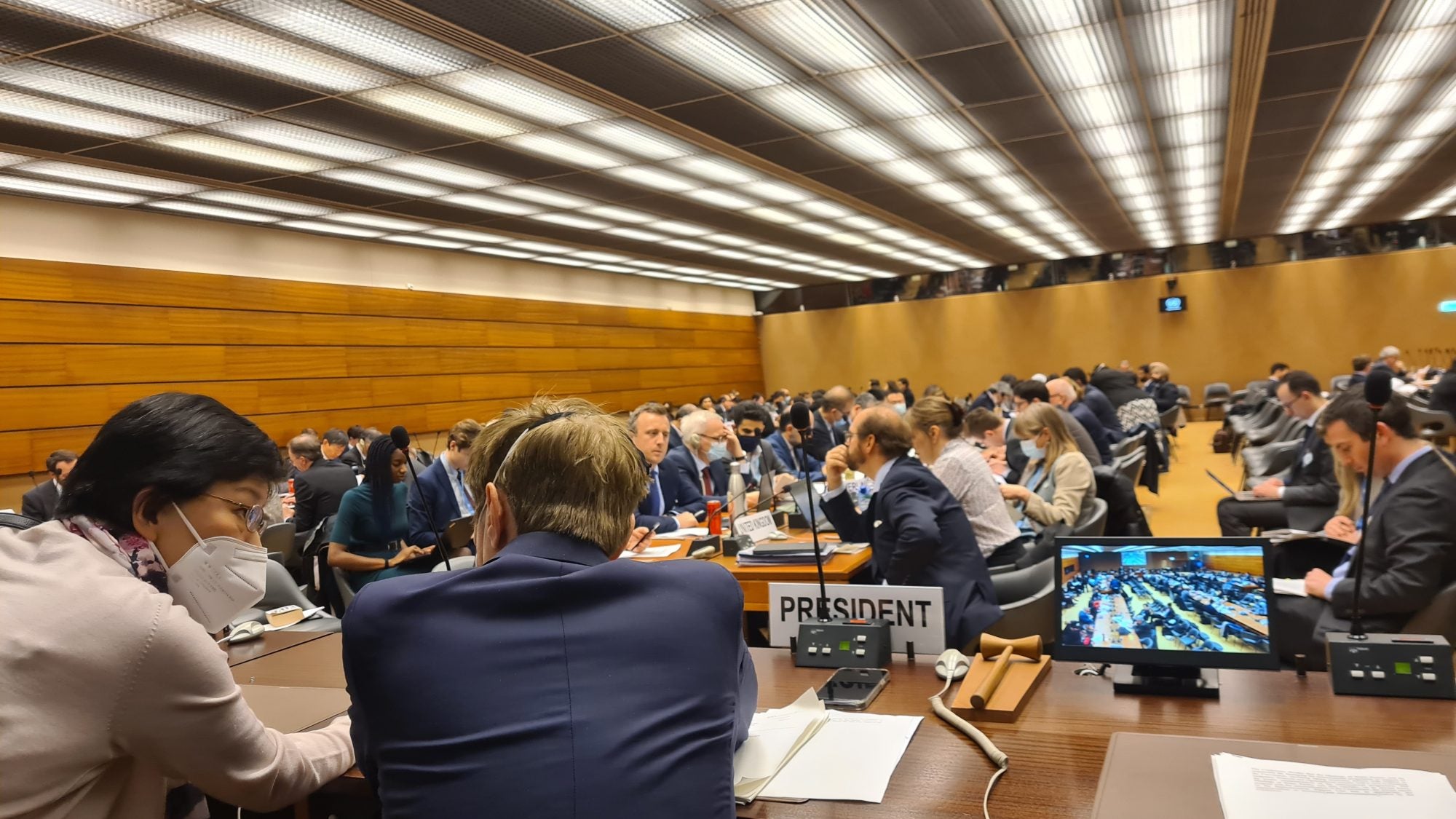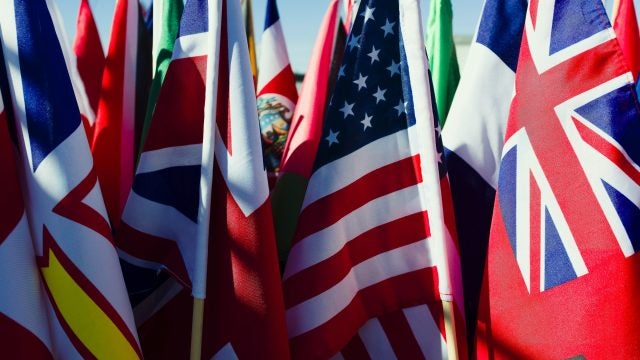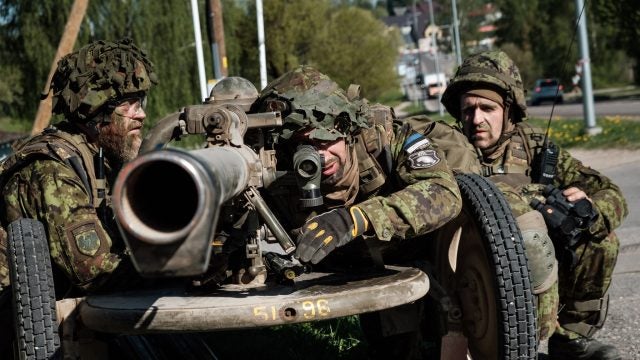
Title: Biological Weapons Convention: In the Crosshairs of Geopolitical Tensions, Part 2
The Biological Weapons Convention has become an outlet for geopolitical tensions heightened by the war in Ukraine. This two-part article charts how the diplomatic battle between Moscow and Washington for control of the narrative on treaty compliance and verification is at a precarious point.
The Road to the BWC Review Conference
At the General Assembly’s First Committee meeting in October 2022, Russia claimed its questions about “military and biological activities” by the United States and Ukraine had not received “exhaustive answers” at the formal consultative meeting in September and that “the issues remain open and pending solutions.” Russia made clear that it intended to pursue its claims at the review conference and that it would not necessarily limit itself to consultations and exchanges of views but may well “engage the entire toolbox envisaged by the Convention,” including making requests for an investigation of non-compliance to the Security Council under Article VI of the BWC.
In response, the United States called on Russia to end its “massive disinformation campaign” while also utilizing its statement to adopt a more constructive and forward-looking approach. The statement characterized the BWC as being at “a momentous crossroads” and called on parties to “embrace this moment to chart a new course” for the treaty, endorsing a proposal to establish a two-year expert working group to strengthen the BWC and create “a path for developing approaches to the more challenging questions of verification and compliance.”
There were two significant draft resolutions: the annual Hungary-sponsored resolution on the BWC, which managed to craft language describing the formal consultative meeting that was deemed acceptable enough to preserve consensus, and another draft resolution from Russia on the UN Secretary-General’s Mechanism which was, yet again, overwhelmingly rejected for a third time. Despite the failed vote, Russia’s initiative still had considerable impact. The introduction of the draft resolution obliged delegations to engage with it and discuss verification and compliance in informal meetings, consultations, and negotiations, which had agenda-setting impacts. Regardless of the results of the vote, the case for needing to strengthen compliance and verification within the BWC—highlighting the US’s reluctance to do so—had been made.
While Russia had signaled the possibility of requesting a Security Council investigation of its allegations, arms control diplomats were still caught off guard when Russia tabled a draft Security Council resolution under Article VI of the BWC in late October to request the inquiry. Russia’s move was especially startling as the mechanism had never been invoked, the review conference was just weeks away, and the draft had not been preceded by the sort of substantive and diplomatic work you would have expected on the text ahead of its introduction. To observers, Russia’s request was not a serious proposal; the draft resolution lacked any detail on how the investigative commission would do its work, who would chair it, what activities it would undertake, how it would acquire and review information, and why it only had one month to complete its work. The permanent members of the Security Council voted three (France, UK, United States) to two (Russia, China) against the resolution. The Council’s ten elected members abstained from the vote, which could be interpreted as support for Russia, indecisiveness, or lack of engagement, but, as at the formal consultative meeting, the silence could also be understood as an active, coordinated and collective protest against Moscow’s diplomatic maneuvers. After the resolution was voted down, Russia was ostensibly “extremely disappointed” but it was demonstrably clear that Moscow was the party actively driving the agenda.
The Review Conference
The setting for the BWC review conference could not have been more complex. To prepare, the Italian presidency facilitated multiple rounds of consultations as well as a two-day retreat for states parties on the main issues. While building a constructive dialogue was an important step, the odds of success at the review conference were not very high, and it was clear that the conflict in Ukraine was going to play a significant part of the conversation. To prevent Russia and the United States from monopolizing the debate, the Italian team involved as many perspectives as possible in the conversation. The diverse composition of the bureau was instrumental to the outcome—it was the youngest bureau in the history of BWC review conferences and certainly the most gender diverse, with two women (from Moldova and Sweden) chairing the main committees and representatives of all regions acting as facilitators (Malawi, North Macedonia, the Netherlands, Panama, Philippines).
At the review conference, while the “committee of the whole” was negotiating the central part of the final document that reviews the convention article-by-article, the “drafting committee” was blocked from meeting formally. Through a compromise, the committee was able to meet informally, tackling several key questions: how to structure the next intercessional period, what to do to strengthen implementation and universalization of the Convention, which initiatives to endorse from the many proposals of the previous cycle, and whether to reinforce the treaty’s secretariat, known as the Implementation Support Unit.
These two aspects, the backward-looking part of the committee of the whole and the forward-looking part of the drafting committee, are usually reflected in discrete parts of the final document, but they should be considered two sides of the same coin. However, at the review conference, keeping disputes between the United States and Russia out of the article-by-article review of language for Articles V and VI proved impossible. Contrary to the First Committee compromise in the BWC resolution, a factual reference was no longer deemed acceptable. Russia would not accept anything less than a call for a consensual solution to its allegations while the United States and Ukraine would not accept language going further than simply noting the formal consultative meeting and the vote in the Security Council, since it could have implications for a possible future continuation of that argument. This deadlock resulted in the complete deletion of the entire section from the final document.
Losing that substantive political section could have prejudiced the whole text. To avoid this, generating buy-in and commitments from all delegations surrounding the details of the other sections proved critical, which led to a long series of informal consultations with key delegations. Although different visions emerged, each party was interested in strengthening the Convention (in their own way); solutions included resurrecting the work of the Ad Hoc Group from the 1990s, establishing an open-ended working group for the entire review cycle, convening a group of governmental experts on specific measures for a couple of years, and launching an expert group on verification. The impossible mission became how to put together so many differing ideas and elements into one unified vision. In the end, the review conference agreed to a comprehensive mandate for a new working group “to identify, examine and develop specific and effective measures, including possible legally-binding measures, and to make recommendations to strengthen and institutionalize the Convention in all its aspects.” A set of seven areas was agreed, including “compliance and verification,” a topic that had finally come back onto the treaty agenda after a two-decade absence. The new working group was given fifteen days every year from 2023 to 2026 for its substantive sessions, but a sense of urgency was instilled as the group was asked to complete its work “as soon as possible, preferably before the end of 2025.”
The new working group was not the only outcome of the review conference. The decision to establish two mechanisms, one on the full implementation of international cooperation and assistance (Article X) and the other on the review of scientific and technological developments relevant to the Convention, was made “in principle.” In other words, parties affirmed the need for the BWC to have such mechanisms, but it was not yet possible to agree on all the elements for them to function, despite the best efforts of the facilitators. Still, these decisions represented an important milestone, and the working group will give the mechanisms a dedicated focus in the future. Additionally, a new person will be recruited to the treaty secretariat to support the working group; just one, but even moving from three to four was relevant progress.
The efforts of the Italian presidency bore fruit, and the consensual approval of the final review conference document was welcomed by the UN Secretary-General as “a glimmer of hope in an overall bleak international security environment,” which allowed the disarmament community to close the year with some relief.
An Opportunity to Reclaim the Narrative
After the extraordinary and intense events of 2022, it seems reasonable to ask whether the BWC has entered a new phase or whether the same political dynamics that have long caused a stalemate will continue in the same form. Geopolitically, in terms of disarmament and international security, the situation has not improved. The war in Ukraine continues and so do Russia’s allegations surrounding US bioweapons.
In March 2023, Geneva hosted its first session devoted to organizational issues for the working group, electing a bureau (led by Brazil and joined by France and Georgia) and agreeing on an agenda and a schedule of activities. Just a few days after the March meeting, a parliamentary commission in the Duma concluded that the United States has, since 1991, been implementing plans for military biological exploitation of post-Soviet countries and the world more generally. Biosecurity continued to form part of high-level talks between Presidents Putin and Xi in March 2023, with the two sides expressing “serious concern about the biological military activities of the United States, both inside and outside the country, which seriously threaten other countries and undermine the security of relevant regions.”
Ultimately, it seems clear that Russia will continue to demand clarifications from the United States, at least as long as the war in Ukraine continues. These allegations and their impacts on the international security community are part of the conflict; they are not a side show but instead a dimension of the clash between two different visions of the world. In terms of biosecurity, imagining reconciliation as long as this clash continues seems difficult, and it risks significantly eroding what remains of the international architecture against the proliferation of biological weapons. If there is a lesson to draw from the events in 2022, particularly the review conference, it is that the BWC still matters for many. Even when interests were far apart, states were still able to negotiate and agree on an ambitious plan for the next several years.
The working group seems set to be the next arena of confrontation. It is scheduled to start its substantive work in August considering “classic” topics like international cooperation and review of science and technology. The first fireworks will likely come in December, when discussion on compliance and verification is formally on the agenda. It is hard to look at verification as a new topic, since much work—in the Ad Hoc Group but also elsewhere and more recently—has already been done. At the same time, these issues have not been discussed in BWC meetings for many years and today’s context requires a new approach. If Russia, China, and others insist on linking compliance with the negotiation of a legally binding protocol to deal with all the provisions of the BWC, it will be extremely difficult for the working group to evolve towards consensual recommendations.
The Convention is at a turning point. Even if many challenges remain, the positive outcomes of the review conference cannot be ignored. 2025, with the one hundredth anniversary of the Geneva Protocol and the fiftieth anniversary of the entry into force of the BWC, will represent a symbolic milestone. States parties now have three (worst case four) years to prove that it is in their collective interests to find concrete solutions to strengthen the Convention. For delegations that care about biosecurity, the new intercessional process is an opportunity to reclaim the narrative on verification and compliance.
. . .
Dr. Filippa Lentzos is associate professor of science and international security at King’s College London, where she is jointly appointed in the Department of War Studies and the Department of Global Health & Social Medicine. She is also an associate senior researcher at the Stockholm International Peace Research Institute (SIPRI), a non-resident scholar at the James Martin Center for Nonproliferation Studies (CNS), and she serves as the NGO coordinator for the Biological Weapons Convention.
Mr. Tancredi Francese is a career diplomat, currently serving as Deputy Permanent Representative to the Conference on Disarmament at the Italian Mission to the UN in Geneva. He co-chaired the preparatory committee of the ninth BWC review conference and was part of the Italian presidency of the BWC review conference, acting, among other roles, as facilitator for negotiations on the next intercessional process.
Image Credits: Tancredi Francese
Recommended Articles

On May 20, 2025, the World Health Assembly unanimously adopted the World Health Organization (WHO) Pandemic Agreement, an international treaty designed to strengthen pandemic prevention, preparedness, and…

As the Trump administration proposes a sweeping overhaul of the US foreign assistance architecture by dismantling USAID, the Millennium Challenge Corporation (MCC), and restructuring the State Department, there is an…

The Trump administration’s abandonment of allies and embrace of Putin’s Russia has raised pressing questions about whether Estonia, Latvia, and Lithuania can continue to rely on NATO for…